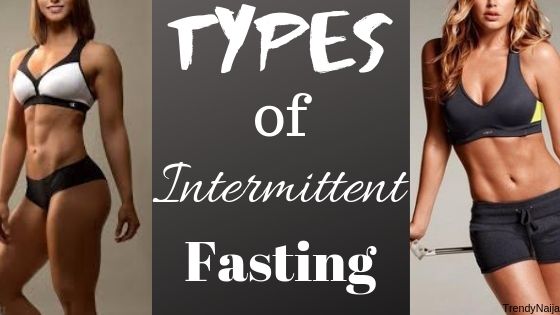
This article is very helpful for you if you want to find out about the different types of intermittent fasting and what each entail.
Even though it became popular about 10 years ago, you should know that intermittent fasting has always been around spanning across various religions and cultures from all over the world over a thousand years ago.
There are quite a number of ways you can carry out intermittent fasting effectively as evidently carried out by some celebrities you know, well, if you are guessing who, you might want to check out Vanessa Hudgens, is that not the reason most people want to try it out? The fact that you can fast and do so on your own terms.
Intermittent fasting is quite simply explained as you stopping the consumption of food for a time frame in order to achieve some optimal results. Below, I will share with you 12 different types of intermittent fasting and their health benefits. You might want to grab a seat and enjoy this read so you can make your choice or maybe for you to be enlightened on the topic itself.
DIFFERENT TYPES OF INTERMITTENT FASTING
16/8 Intermittent Fasting
Do you know Martin Berkhan of Leangains? Okay, if you do not know him like know him then have you heard about him in the very least? First time I heard about intermittent fasting, just like you are doing right now, I combed the internet for everything I could find helpful about it, that was when I actually found Martin Berkhan who actually popularized 16/8 intermittent fasting, well, to me and others who found his book helpful.
I was trying to reduce the bloat in my stomach when I discovered this type of fast and it is the perfect fit for anyone trying to train hard and still lose fat at the same time. And it is very simple, you just fast for 16 hours and you eat within 8 hours. You can try to have 2-3 major meals within this time frame and seriously avoid overeating while doing so.
This type of fast has many health benefits like increased focus, reduced fat, healthy mind and improved digestion. In my opinion breaking your fast with more vegetables and fruits included in your main meals is healthier than focusing just on your main meals. You can decide to work out between your first and second meals if that is convenient for you. There are other types like this too which are also based on the number of hours you fast over the number of hours you eat so other intermittent fasting like 17/9, 16,6/9,4 etc, are all example you can explore in this category.
One Meal A Day (OMAD)
With this type of intermittent fasting, you get to eat your food within one to two hours time-frame after fasting for about 21-23 hours. People who practice this type of fast claim that it helps them feel full even though they are cutting back on calories and hence consider it a very great way for dieting. It is also considered as one of the simplest because it’s done once you eat your one-time meal for the day.
You might find this quite easy if you are already keto-adapted because such dieters claim it is really enjoyable because they can fast as long as they want as they do not feel hungry during the day. One of the benefits is that you get lose fats very fast although its limited time for protein anabolism and synthesis makes it a no-no choice for those who really want to build their muscles.
24-Hour Fasting.
This type of intermittent fasting is actually prescribed by the Author of Eat Stop Eat, Brad Pilon. It is regarded as one of the most basic type of intermittent fasting because you do not eat for 24 hours, yea, that is a whole day, after this then you can have free access to food again. Eventually, you may not have to fast throughout the day, you can simply take just dinners and do the same the following day.
This fast might end up not being effective if you over eat, which would surely lead to weight gain, so, the purpose for this type of fast is basically to under eat and cut back greatly on calories intake. Aside losing weight, another major advantage for this type of intermittent fasting is that there is no fixed rule on how long you must go on fasting as that is fully dependent on individuals and their energy levels.
24-Hour Fasting is actually an option an overweight person who hardly exercise but really want to lose some weight might want to fast as long as they want until they have achieved their weight loss goals.
Although fasting is often considered an aberrant word generally in the fitness world and the modern food environment, it is still one of the fastest ways people can consider when they want to lose weight.
Alternate Day Fasting
This type of intermittent fasting allows for the consumption of up to 500 calories on days of food abstinence. You should note that these number of calories are allowed in order to ensure compliance with the fasting period. This type of intermittent fasting is recommended by experts for those who want to fast but cannot handle the stress of fasting like their whole physiological makeup can handle because apparently, everyone can fast. However, though some positive benefits of fasting would be accrued it would not match the ones that people on full time intermittent fasting will enjoy.
The Warrior Diet
Author, Ori Hofmekler wrote a great deal about the Warrior Diet, which is another type of intermittent fasting. This type of fasting is a combination of going without food and working out. The fast is often for 20 hours, after which you get to work out and take your meal within 4 hours. One can eat 2 small meals within this 4 hour of eating window or just eat once. Some of the benefits of the warrior diet is improvement in body’s physical condition, improved mental attitude and mindset and the development of ability to tolerate stressful conditions.
This type of intermittent fasting can be traced back to the Spartan and Roman warriors who keep fit all day by training and only ate in the evening. They only snacked on foods like fruits and vegetable while doing their normal daily duties, even the hot weather during the day time did not bother them as they went about their duties of building fortresses, carrying heavy equipment among other things they do. However, in the evening, they ate their normal meal portion, which were mostly breads, stews, meats and other kind of foods. One of the first books I read about intermittent fasting was The Warrior Diet by Ori Hofmekler. He talks a lot about the benefits of fasting on stress adaptation through the phenomenon of hormesis.
Fasting Mimicking Diet (FMD)
In a month you get to restrict yourself to just 800-1000 calories each day for 2-5days, on the sixth day, you will be able to go back to your normal eating routine. This kind of fast is known to have positive effects on longevity while it helps in reducing blood pressure, lower insulin and suppress IGF-1 because of the restriction placed on calories intake.
To prevent unwanted loss of lean mass, you can adjust the macronutrient ratios of the FMD and make them more ketogenic by lowering the carbs and increasing the fat slightly.
36-Hour Fasting
This type of intermittent fasting entails you not eating for a whole day and for 12 hours the next day before you now eat again. Most times, people eat in the evening and fast the next day and half a day the next day.
It is widely acclaimed that you can speed up the process of autophagy for the best results by taking low carb before starting your fast for each phase. It is also believed that people from centuries past were able to beat cancers and other life-threatening ailments because of their fasting practices.
The 36-hour intermittent fasting is made easier with your ever available and handy sparkling water, black coffee, mineral water, herbal teas and green tea. Once you are able to fast over 24 hours, the effects of the fast begin to show, by this time, you would have experienced energy deprivation and your body would then be forced to trigger its longevity pathways which is one of the benefits of this kind of intermittent fasting. It helps to boost stem cells, recycle old worn out cells through autophagy and helps mobilize fat stores.
48-Hour Fasting
Well, if you can survive the 36-hour fast, nothing says you cannot thrive if you go on fasting for 48 hours. If you already made it to the 36-hour mark, then why not just fast for the entire 48 hours. Really, this fast is most difficult during the first 24 hours. You will definitely overcome this initial state and become very good at intermittent fasting without complications if you can sleep and wake on an empty stomach.
Extended Fasting for 3-7 Days
Fasting for over 3 days is another type of intermittent fasting, which is designed to give you a lasting boost in autophagy while you get to burn more fats faster. A test carried out on mice showed that their immune system can be reset with 72-hours fast. This type of intermittent fasting is applauded for its numerous benefits like immune system boost, generation of blood cells, and cleared pathways for hematopoietic stem cells.
Majority of people do not need to fast beyond 3-7 days in order to avoid losing lean muscle tissue and this is also based on the fact that autophagy optimal time frame is between 3-5 days.
If you are out to cleaning out your system or you want to promote cellular healing, experts recommend this type of intermittent fast because of its amazing benefits. Doctors recommend this fast for people suffering from one kind of medical condition or the other to hasten self-healing. Also, those who are obese can try it out for quick results. Please kindly note that I am not a medical doctor and it is best to consult your doctor before embarking on this kind of fast for any of the listed purposes. The process involves fasting for 3-5 days and eating, you can continue the process until you have achieved your desired results.
Fat Fasting
During this type of intermittent fasting, instead of glucose, fat and ketones are used as a primary fuel source for your body and this allows you to get access to energy as you keep burning your own body fat.
Even though it might most likely suppress autophagy to a little extent, your sole consumption of fat can’t actually kick you out of ketosis as reported by users of this method; in addition, it is supposed to raise your ketones. Even though it is not as effective as macro autophagy, chaperone-mediated autophagy can still save ketones and maintain their effects.
This kind of intermittent fasting promotes adherence as it ensures you do not quit halfway into the fast. Well, you do not need to stick to just fat, but you should note that any carb or protein foods like bone broth, coconut milk, coconut water and similar kind of foods will trample the purpose for this kind of intermittent fasting.
Protein Sparing Modified Fasting
Just like the name implies, this intermittent fasting is a high protein kind of diet, which helps in promoting muscle maintenance while facilitating the process of fat loss. You actually have to feed on low carb and fat while fasting to achieve optimum results as widely acclaimed.
When people who are into fitness are doing intermittent fasting, they are often greatly concerned about maintaining lean muscles. Keeping lean muscle mass is a big matter of concern for people who are into fitness, especially if they’re trying to do intermittent fasting. Well, intermittent fasting can lead to muscle loss though at a lower rate than people think. This can actually be prevented if you lower the body’s demand for glucose and this can be achieved when you are on keto diet, which can be used in significantly decreasing energy.
You should however be careful of predisposing yourself to catabolism of your muscle when you eat too much of protein, by increasing your fat intake a little bit and regulating your protein intake to as low as 0.8-1.0g/lb of body weight. Again, this should be done on Doctor’s approval, this is just based on the opinions of people who have tested this process.
Bone Broth Fasting
Bone broth fasting can help you inhibit autophagy because it contains some very useful amino acids and it remains a practicable option for anyone who wants to engage in extended fasting. You can supress autophagy for a few hours, which would be activated shortly afterwards if you drink just a single cup of bone broth.
You might need to add other calories in addition to your bone broth as your last option to not tampering with your intermittent fasting if you are fasting for autophagy. But if you are fasting to lose fat then taking large chuck of calories might hamper expected results in this regard. Evident benefits of this type of intermittent fasting is prevention of muscle cramps, brain fog, and lethargy because of the electrolytes and minerals that are present in bone broth.
Dry Fasting
Another way to get autophagic benefits is staying away from liquids, research studies stated that one day of dry fasting is equivalent to not drinking water for three days. The idea behind this is the ability of the body to produce its own metabolic water through the conversion of triglycerides from the adipose tissue. This process is called beta-oxidation whose by-product is hydrogen. Some religions and healing practitioners believe in and practise dry fasting because of its spiritual and healing benefits. To achieve deeper autophagy, it is advisable to practise time-restricted dry fasting between 12-16 hours daily but kindly note that you should be ready to bear the risks if there are any if you practice it as there are not enough scientific studies backing this up.
Less is better when it comes to intermittent fasting, both the size of food and the fasting window, fasting for at least 16 hours and taking about 8 hours to eat, anything more than this is not really necessary except if you can or it is recommended by your doctor. No matter what type of intermittent fasting you do, you will always get about 80 percent of the benefits and it was advised by experts that it is better to adopt one type.

